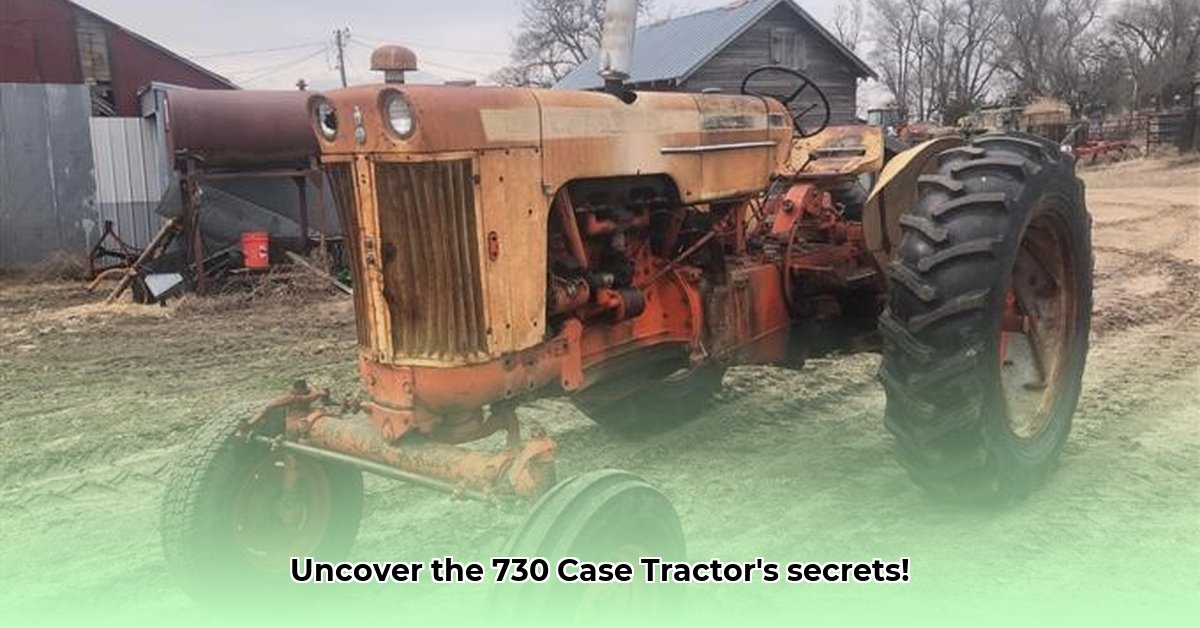
The J.I. Case 730 tractor, produced approximately from the early to late 1960s, represents a significant milestone in agricultural mechanization. This detailed guide explores its specifications, historical context, and lasting legacy, appealing to both tractor enthusiasts and those interested in the history of agricultural technology. For more Case tractor history, see this website.
Powering the Fields: Engine, Transmission, and Variants
The Case 730’s heart was a robust 4.4-liter four-cylinder diesel engine. While precise horsepower figures vary across sources (with estimates ranging from approximately 56 hp to slightly higher), its performance was commendable for its era. Did this power translate to effective field work? Absolutely. Paired with either a torque converter or an unsynchronized gear transmission – a choice dependent on the specific model and intended application – the 730 offered farmers considerable flexibility in tackling diverse field conditions and workloads.
The 730 wasn't a monolithic machine; it encompassed a family of tractors tailored to specific farming needs. Row-crop models featured reduced ground clearance, ideal for navigating closely spaced rows. High-clearance variants catered to taller crops, ensuring minimal damage to crops during operation. Orchard models, with their narrower width, provided maneuverability within the confines of an orchard. This adaptability underscores Case's commitment to providing the right tool for every agricultural task. This strategic approach likely contributed significantly to the 730's widespread adoption.
Detailed Specifications
The following table summarizes the key specifications of the J.I. Case 730 tractor. Note that variations exist across models and available options. Due to the age of the tractor and limited readily available documentation, some values represent estimates based on available data.
| Specification | Value (Approximate) | Notes |
|---|---|---|
| Engine Type | 4-cylinder Diesel | Various gas and LPG options also existed. |
| Engine Displacement | 4.4L | |
| PTO Horsepower | 56 hp (Estimate) | Figures vary depending on the engine type and source; further research is needed. |
| Transmission | Torque Converter, Unsynchronized Gear | Specific transmission type varied with model. |
| Weight (Approximate) | 6,000 - 7,000 lbs | Varied based on configuration and optional equipment. |
| Dimensions | Varied by model | Row crop, standard, high clearance, orchard models all had different dimensions. |
| Notable Feature | Case Eagle Hitch | Facilitated easier implement attachment compared to earlier three-point hitches. |
| Hydraulic Capacity | Varied | Dependent on the model and year of manufacture. |
Sources: A combination of online forums, collector databases, and archived materials were used to compile this information. Further research is required to pinpoint exact figures for all specifications.
A Historical Perspective: The 730 in the 1960s Agricultural Landscape
The 1960s witnessed a dramatic acceleration in agricultural mechanization. Tractors were becoming increasingly powerful and versatile to meet the demands of larger farms and more efficient production. The Case 730, while not as powerful as its modern counterparts, aptly reflected this trend. It represented a significant step forward in technology for its time; a reliable, reasonably powerful workhorse suited to a variety of farming tasks.
While a precise, data-driven comparison with contemporary tractors from John Deere or Ford is currently hampered by data limitations, future research could shed further light on its competitive position within that specific market.
Strengths, Weaknesses, and Legacy
The Case 730's enduring popularity stems from its sturdy build and reliability. Farmers valued its durability and relatively straightforward mechanical design, simplifying maintenance and repair. Its versatility across numerous models further enhanced its appeal. However, its horsepower is modest by modern standards, and it lacks advanced features considered commonplace on contemporary tractors.
Did the 730's simplicity outweigh its lower power and lack of advanced features? The answer lies in its continued presence in many fields and the fact that it remains a sought-after piece of agricultural history amongst collectors and enthusiasts. This highlights its lasting impact and legacy as a dependable workhorse of its era. The relatively long production run (approximately a decade) serves as testament to its success in meeting the needs of farmers during that time.
Conclusion
The J.I. Case 730 remains a compelling subject for study. Further investigation into its specifications, performance data (like torque curves and fuel efficiency), and direct comparisons with competitors will provide a more complete picture of its role in the development of agricultural machinery. Continued research, potentially focusing on archived company documentation, could significantly enrich our understanding of this iconic tractor and its lasting impact on farming.